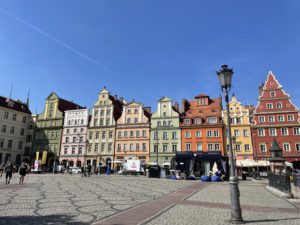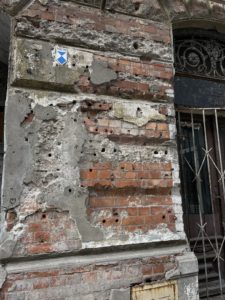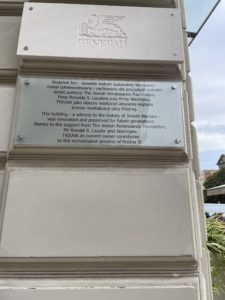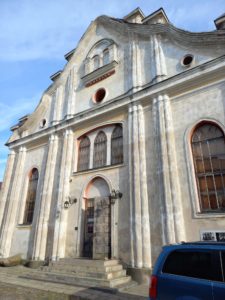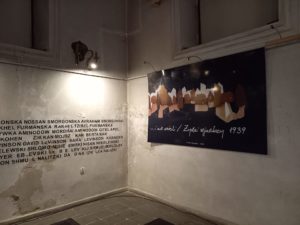Shades of Whiteness: Perceiving Restoration Efforts of Formerly Jewish Spaces Within Poland
By Sierra Kaplan
Every Rynek can leave the average tourist entranced by beauty and history. Buildings of all hues and intricacies decorate all four sides of each historic market square, enmeshing and transporting the sightseer into the distant past. To be in a market square is to concentrate on the details and traces of the past, such as the painted facades or the plaques with construction dates. However, when looking beyond the historic market squares, a new image suddenly appears, one that contrasts with the colorful townhouses of different architectural periods. Renaissance townhouses in Polish market squares are offset by the colorless skylines of high-rises and renovated history. Every other street boasts a new construction underway– often dressed in white like the others. Widespread whiteness has inundated the architectural world, bulldozing eclectic period pieces for emotionless, sleek contemporary exteriors and interiors. This harsh contrast creates a larger yet more complicated picture of Polish city landscapes. Sometimes, decisions to repeatedly remodel and rebuild spaces, regardless of intentions, whitewash Poland’s complex history, which as a result becomes hidden behind new layers of plaster. However, depending on the building, there are several ways to perceive architectural whiteness in Poland – sometimes it memorializes the past; other times it covers it up, making it disappear. Whether a tourist or a local, we must unpeel the layers of white paint and uncover whether the space’s renovation is commemorative or erasure.

Recently Reconstructed Próżna Tenement Now Used for Restaurants, Residences, and Office Space. Photo by Sierra Kaplan.
One street in the heart of Warsaw contains an example of how whiteness has covered up a painful chapter in the city’s past. On Próżna Street, once in the heart of pre-war Jewish Warsaw, buildings on opposite sides of the street tell very different histories. On one side of the street, Próżna 7 and Próżna 9 are renovated historic buildings now housing Warsaw residents and buzzing with coffee shops, restaurants, and office spaces. While the historic structures and architectural details remain, the interior and exterior walls of these two buildings have been submerged in white paint and plaster. Right across the street is Próżna 14, also an original prewar building. In contrast to Próżna 7 and Próżna 9, this building remains largely unfinished and is the sole, untouched physical piece of historical memory. Próżna 14’s façade is draped with a reconstruction banner, visualizing the future look of the building once renovated. Próżna Street belonged to the Warsaw Ghetto and miraculously the buildings on both sides of the street survived World War Two. Próżna 14’s postwar authenticity makes it a site of remembrance: side walls porous with bullet holes, the indentation of a mezuzah in the doorframe, and its dilapidated bricks.
As I ran my hand along the bullet holes that scarred its façade, I felt a similar captivation with its impurities and educational value. The building currently has a banner with its future white appearance, but in the late 2000s, Próżna 14’s exterior revealed photographs of Warsaw’s pre-war Jewish residents. In contrast, Próżna 7 and Próżna 9 almost appear ordinary: white historical buildings that blend into the other reconstructed buildings. So much so that I almost passed them absent-mindedly before our instructor pointed signs on the façade of Prózna 7. All that remains to recognize Prózna 7’s past are these small plaques on the side of the building that indicate the historic importance of the site. However, how do small plaques on the side of a building that people walk by daily, likely unaware, memorialize and preserve the few remnants of the Warsaw Ghetto? Standing side by side, the untouched and renovated tenements create a potent image of the potential losses amid commercialization, whiteness, and time. By eventually reconstructing Prózna 14– the bullet holes, the weathered bricks, the wrought iron gates will – albeit unintentionally – erase the site’s Jewish history. For me, Prózna 14’s original, untouched form is a powerful commemoration, and stands in stark contrast to Prózna 7 and 9. If we re-plaster the walls and remove the images of the former Jewish residents, then an important history will be erased and chances of raising societal awareness about the city’s past. Rather than whiteness, I think preserving this façade as is will only further eternalize the space. I believe we can memorialize spaces, even those in poor shape, without camouflaging historical ruins as clean slates through commercialization.
Muranów is another formerly Jewish neighborhood where whiteness has erased history and previous efforts at commemoration. Starting in the 1950s, a new residential housing district was built on top of the rubble from the Warsaw Ghetto. It was this struggle to develop a postwar residential space that prompted Muranów’s erasure. Unlike Ulica Próżna, where commercialization unintentionally created Jewish erasure, Muranów’s reconstruction evolved into an intentional historical sanitization. While most urban planners prioritized ghetto space for socialist housing development projects, architect Bohdan Lachert blended this goal with his intentions to honor what lay underneath the new housing complex. He wanted to pay tribute to the victims of the ghetto by leaving the buildings’ dark red bricks exposed to commemorate the bloodshed and ruins of the former Warsaw Ghetto. However, such symbolism was short-lived because the Polish Communist Party (PZPR) criticized its “alleged gloomy representation of the ghetto” (Meng, 81). Such dangerous sentiment prompted orders from the PZPR to re-plaster the buildings white and perpetuate a new narrative. From that moment, Muranów became a symbol of a postwar Polish Communist success and history, whitewashing the site of Jewish commemoration. To the ordinary eye, Muranów resembles a regular housing complex. So much so that until we studied the space, I did not realize Muranów’s history as a Jewish quarter that became a part Warsaw Ghetto. But most people do not have historians educating them when they walk through the neighborhood. PZPR’s vision served as a conscious erasure of the former Jewish space to further ideological, political, and historical goals. In so doing, party officials replaced Lachert’s effort at commemorating Jewish history, culture and trauma at the time when the area was being transformed into a housing complex. Today, most of Muranów’s residents remain unaware of the rubble-made hills and ghetto bricks. However, I think increased education and memorials within the complex can attempt to resurrect Lachert’s intentions for memorializing the Jewish space.
Sometimes, white is not so bad. When used sensitively, white can serve to reclaim a space and its history, giving it a newfound meaning. In Sejny, a small northeastern Polish town marked by a history of shifting borders and tragedy, the renovation of the White Synagogue is an example of how whiteness can serve to honor the past. While no Jewish community exists in Sejny today, in the mid-nineteenth century, Jews comprised nearly 75% of the population. They formed a community in the White Synagogue, which once bustled with life and Jewish culture. Jews began leaving Sejny in the early 20th century, overwhelmed by social and economic turmoil, forcing a majority to resettle westward to the United States. At the start of the Second World War, the Nazis deported the remaining Jews, and the majority were murdered. During the war, the synagogue experienced similar displacement. The Nazi occupiers erased the Jewish space by looting the interior furnishings; the entire shul’s culture was stripped and sent to Germany, never seen or recovered again. Once the synagogue lost its religious significance, the Nazis converted the space into a fire station. But without a surviving Jewish community, after the war the building constantly changed hands. Over time, the synagogue was used for multiple purposes: a fertilizer warehouse, transport base, car depot, shoe store, and post office. The White Synagogue experienced some restoration in the 1980s, which erased the Nazi era changes. Starting in the 1990s, the Synagogue was “stateless”. It was in that time that it passed into the hands of the Borderlands Foundation, which represented a new chapter for the White Synagogue acts in which the Jewish heritage of Sejny was reclaimed even without the thriving community that once existed. Inside the synagogue, the Borderland Foundation painted the interior white, symbolizing this fresh start for a building wrongly occupied and defaced. The Borderlands reintroduced life and color into the synagogue– even if the literal space is now white– by using it as a concert venue, conference hall, and tourist spot. Despite its multipurpose use, the Borderlands Foundation preserves the integrity of the building, educates about Sejny Jewry, and honors a community forgotten by history, even by Sejny’s residents. And when visitors come, they see its unique interior. Every white plastered wall contains the names of 500 Sejny Jews who died in the Holocaust; a menorah rests in a niche above the names of those being memorialized. Hanging from the ceiling, a Judaic tapestry, marking the space where the bimah would once stood. Initially, I felt conflicted about being in the space, asking myself if reusing the synagogue felt appropriate. But after learning at Auschwitz about Holocaust victims in my family whose deaths and stories remain unknown and forgotten, I understand how reopening these doors and placing the names on the walls returns the memories of the forgotten Jews of Sejny. And by doing so, it reintroduces kehillah, or community, to Sejny, an important value in Judaism and the repurposed Sejny Synagogue.
Whiteness can erase the Jewish past or reclaim it. Rather than reconstructing and repurposing the White Synagogue for new commercial ventures and vendors, the restoration of the space differs from the unintentional erasure of Ulica Próżna. The Borderland Foundation has memorialized Jews and is educating the population about the town’s Jewish past, unpeeling and uncovering the layers of history. In contrast, the whiteness and repurposing of Ulica Próżna’s tenements hide Jewish spaces under plaster where there was once color, culture, and tragedy. Whiteness can be positive, but it remains dependent on the intentions of its painters.
References
- Connelly, J. (2012, December 3). The Noble and the Base: Poland and the Holocaust. The Nation. https://www.thenation.com/article/archive/noble-and-base-poland-and-holocaust/
- Gera, V. (2013, January 31). Attempt to save Warsaw Ghetto Building. Independent Online. https://www.iol.co.za/mercury/world/attempt-to-save-warsaw-ghetto-building-1462212
- Grodzka Gate – NN Theater. (n.d.). Sejny – Guidebook. Shtetl Routes . https://shtetlroutes.eu/en/sejny-przewodnik/#:~:text=In%20the%20mid%2D19th%20century,the%20right%20to%20do%20so.
- Meng, M. (2011). Shattered spaces: Encountering Jewish ruins in postwar Germany and Poland. Harvard University Press.
- Ministry of Foreign Affairs of the Republic of Poland. (2021). Sejny. Synagogues-Fodz. https://www.synagogues-fodz.com/pl/sejny
- POLIN Museum of the History of Polish Jews. (n.d.). Synagogue in Sejny. Wirtualny Sztetl. https://sztetl.org.pl/pl/miejscowosci/s/685-sejny/112-synagogi-domy-modlitwy-mykwy
- Snyder, D. (2012, November 23). The Ghosts of Muranów: A journalist’s mission to illuminate Poland’s Haunted Past. NBCNews.com. https://www.nbcnews.com/news/world/ghosts-muranow-journalists-mission-illuminate-polands-haunted-past-flna1c7220129
- Warsaw Próżna 14 st. Bronze Mezuzah. MI POLIN. (2023, September 19). https://www.mipolin.pl/produkt/warszawa-ul-prozna-14/
- Zakrzewski, P. (2019, June 21). Greetings from Sejny: Sounds & images from the Borderland. Culture.pl. https://culture.pl/en/article/greetings-from-sejny-sounds-images-from-the-borderland


